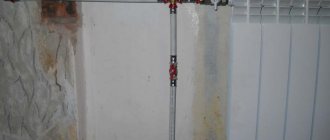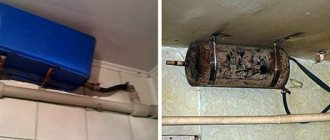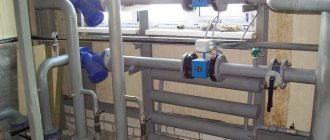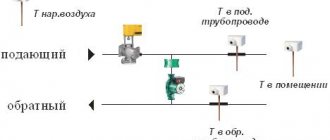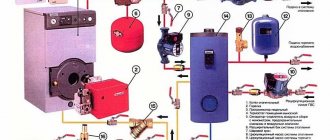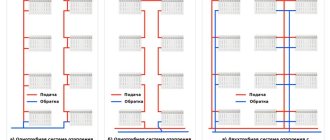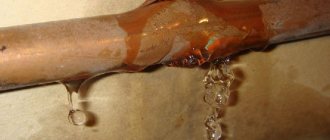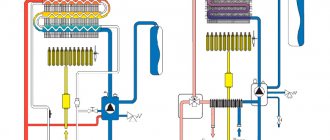The circulation pump increases the efficiency of the autonomous heating system and allows 100% use of all heating circuits.
Professional installation of a heating pump guarantees high performance, reduces operating noise and reduces maintenance and repair costs. Installing the device does not cause any particular difficulties, but there are a number of nuances that are important to consider.
We will tell you how to choose a circulation pump, help you decide on the optimal scheme for inserting equipment into the system, outline installation requirements, and also provide step-by-step instructions for installing the device.
Purpose of the pump for heating
Previously, circulation pumps were used only in centralized heating systems, and for private housing construction the natural movement of the coolant caused by temperature differences was the norm.
Now forced circulation is used everywhere thanks to the emergence of compact and inexpensive models designed to service the heating networks of small houses and cottages.
Due to the increase in the speed of movement of the coolant in the pipeline, thermal energy flows faster to the heating radiators, and accordingly, the rooms are warmed up faster. The load on the boiler has decreased because the water is also heated faster.
The need to install bulky and inconvenient large-diameter pipelines has disappeared; contours have become easier to camouflage under floor coverings or be buried in walls.
The main disadvantage of pumps for heating systems is their dependence on electricity. If the power supply is intermittent or there is a risk of a complete power outage for some period, it is necessary to install a backup power generator or at least an uninterruptible power supply.
The remaining disadvantages relate to the designs and functionality of various types of devices. For example, monoblock units and devices with a dry rotor are noisier and require constant maintenance, while a pump with a wet rotor is demanding on the quality of the coolant and has a pressure limitation.
Criteria for proper selection of equipment
All installation efforts will be reduced to zero if the equipment is selected incorrectly. In order not to make a mistake, it is necessary to first analyze all aspects of a particular heating system and make the necessary calculations.
Main types of pumps
According to their design features, all devices are divided into 2 categories: with a wet and dry rotor.
Wet type pumps . This option is suitable for private homes. The unit is compact, almost silent and has a modular structure that is convenient for maintenance and repair.
But, unfortunately, it does not have high productivity - the maximum efficiency of modern models reaches 52-54%.
Pumps with a dry rotor are productive, unpretentious to the quality of the coolant, capable of operating under high pressure and do not require a strictly horizontal position on the pipe. However, they are noisier, and their operation is accompanied by vibration. Many models are installed on a foundation or metal support frame.
For installation of console, monoblock or “In-line” models, a separate room is required - a boiler room. It is advisable to use them when a flow rate of more than 100 m³/h is required, that is, for servicing groups of cottages or apartment buildings.
Brief overview of technical characteristics
When choosing a pump, you should definitely study the technical characteristics and compare them with the requirements of the heating system.
The following indicators are important:
- pressure , which covers hydraulic losses in the circuit;
- productivity - volume of water or supply over a certain time interval;
- operating coolant temperature , max and min – for modern models on average +2 ºС… +110 ºС;
- power – taking into account hydraulic losses, mechanical power prevails over useful power.
Structural details are also important, for example, the inlet/outlet diameter of the pipes. For heating systems, the average parameters are 25 mm and 32 mm.
An example of a unit for equipping a residential heating network with an area of 100 m² is a Grundfos UPS with a 32 mm pipe connection, a capacity of 62 l/s and a weight of 3.65 kg. The compact and low-noise cast iron device is inaudible even behind a thin partition, and its power is sufficient to transport liquid to the 2nd floor.
Pumps with built-in electronics allow you to quickly switch equipment to a more convenient mode depending on changes in temperature or pressure in the network. Automatic devices are equipped with digital displays that provide maximum information on the operation of the pump: temperature, resistance, pressure, etc.
Additional information on the calculation and selection of a circulation pump for heating is presented in the articles:
Requirements for installation of a circulation pump
There are a number of standards that regulate at the legislative level the installation of a circulation pump in a heating system. Some of the rules are set out in SNiP 2.04.05 “Heating...”. For example, it talks about the priority of schemes with forced circulation in heating networks.
Almost all requirements are justified by the operating efficiency of the system as a whole and the circulation device in particular. For example, the shaft of a device with a wet rotor must be installed on the pipe strictly horizontally in level so that there are no air pockets inside and the pump parts do not wear out prematurely.
A filter for dirt and abrasive particles is needed in any case, even when installing monolithic models. Filtered coolant will cause much less damage to pump parts than liquid with sand and suspended matter.
The mudguard is installed with the plug down in the direction of water movement to reduce resistance and facilitate system maintenance.
Some rules are dictated by manufacturers. For example, it was customary to install old models of certain brands exclusively on the return line, since they could not withstand high temperatures.
Now pumps have become more versatile and can be installed in any suitable location, but subject to power parameters.
Main functions of a circulation pump
If we talk specifically about apartment buildings, then most of the residents of the upper floors know very well what cold radiators are. This happens because the pressure in the system is not enough for its full functioning. The working fluid moves too slowly through the pipeline and loses most of the heat on the first floors. As for the owners of country houses, they may also encounter a similar situation: for example, at the most remote point of the heating main, the radiators may be too cold. All these problems can be solved by installing a circulation pump.
Important information! It is worth noting that a network with natural circulation of working fluid is quite effective in small buildings, but even there it is advisable to think about providing forced circulation.
In fact, any circulation pump is just a rotor placed in a working fluid. During operation, the latter rotates, forcing the coolant to move along the line at the required speed, thereby creating the required pressure. There are several operating modes of the pump. Thus, when the limit mode is activated, it is possible to achieve record-breaking rapid heating of a house that has cooled down during the absence of residents. After heating, the settings are restored in order to obtain the maximum amount of thermal energy with minimal energy consumption. The devices come with either a “wet” or a “dry” rotor (we’ll talk about this in more detail in the next paragraph of the article). But let’s make a reservation that “wet” rotors are completely immersed in the working fluid, but “dry” ones, accordingly, are only partially immersed.
Important information! “Wet” devices create much less noise during operation.
Video - Circulation pumps
Brief installation instructions
A common option is to install the pump on a bypass. This is due to two good reasons: it becomes possible to quickly dismantle or temporarily disconnect the device from the network, for example, if problems arise with electricity.
Various modifications of ready-made pumping units are available for sale: for welding or flange connection, with places for installing taps or valves, with a special area reserved for the pump.
But if you cannot purchase a ready-made unit or there is not enough space for its installation, you can independently organize the bypass piping and fix all the parts in the places allocated for them.
The following tools and materials are required for work:
- a set of open-end or adjustable wrenches for assembly;
- pliers:
- linen thread or tow;
- Unipak sealant.
American nuts are usually supplied with the pump, but taps, adapters or fittings will also have to be prepared. Attention should be paid to more reliable materials for making fittings and the diameter of the products.
- Assembling units with taps . Two will be located on the edges of the pump, the third will become part of a straight pipe. It is important to measure the “return” section in order to accurately weld the fragment with the tap.
- Assembling the pump loop. Tightening the nuts must be postponed until the final stage of installation, but for now they just need to be screwed on.
- Trying on the bypass loop . Mark the places where the units are welded into the pipe.
- Welding should be left to a qualified welder.
- Assembly of the lower unit is on the “return” side.
- Connecting the pump to the power supply.
As an example, install the GRUNDFOS .
Maintenance of the installed pump is carried out in operating mode. It is necessary to clean the filter more often and check the pressure gauge readings.
If the values do not correspond to the norm, the device must be removed and adjusted. It is better to do this in a specialized workshop.
Conclusions and useful video on the topic
Theoretical knowledge is quickly absorbed when accompanied by an interesting video that reveals the sequence and features of the work on installing devices.
Video review of the WILO pump – configuration and installation:
Practice shows that advanced home improvement enthusiasts can handle installing a circulation pump on their own.
However, if difficulties arise, it is better to turn to specialists: only qualified craftsmen know how to properly tie and install a heating pump, observing all the nuances of the chosen scheme.
Do you have personal experience installing a circulation pump? Do you want to share your accumulated knowledge or ask questions on the topic? Please leave comments and participate in discussions - the feedback form is located below.
Installing a circulation pump in homes with an individual heating system ensures uniform and high-quality heat distribution throughout all rooms of the house.
Harness
There are two types of heating systems - forced and natural circulation. Systems with forced circulation cannot work without a pump; systems with natural circulation work, but in this mode they have lower heat transfer. However, less heat is still much better than no heat at all, so in areas where electricity is often cut off, the system is designed as hydraulic (with natural circulation), and then a pump is installed into it. This gives high heating efficiency and reliability. It is clear that the installation of a circulation pump in these systems is different.
All heating systems with heated floors are forced - without a pump, the coolant will not pass through such large circuits
Forced circulation
Since a forced circulation heating system without a pump is inoperative, it is installed directly into the gap in the supply or return pipe (of your choice).
Most problems with the circulation pump arise due to the presence of mechanical impurities (sand, other abrasive particles) in the coolant. They can jam the impeller and stop the motor. Therefore, a mesh dirt filter must be placed in front of the unit.
Installing a circulation pump in a forced circulation system
It is also advisable to install ball valves on both sides. They will make it possible to replace or repair the device without draining the coolant from the system. Turn off the taps and remove the unit. Only that part of the water that was directly in this piece of the system is drained.
Types of pumps and their features
Various circulation units can be installed in the heating system of a private house. They are divided into two large groups. The circulation pump can be “dry” or “wet”. When installing devices of the first type with your own hands, you should take into account that their motor is separated from the working part by sealing rings. They are made from stainless steel. During the startup of the installation, the process of movement of these rings begins, which leads to sealing of the connection with a water (very thin) film. The latter is located between the seals.
Circulation pump unit
High-quality sealing in this case is ensured due to the fact that the pressure in the external atmosphere and in the heating system itself is characterized by different indicators. A “dry” pump makes quite loud sounds when operating. In this regard, its installation is always carried out in a specially soundproofed separate room of a private house. The efficiency of such a circulation unit is at the level of 80%.
There are three types of “dry” devices for connecting to the heating system: horizontal, vertical, block. The electric motor in units of the first type is placed horizontally. The discharge pipe is attached to them on the body of the device, and the suction pipe is attached to the shaft (on its front side). In vertical installations, the pipes are on the same axis. And the engine in this case is located vertically. In block circulation units, heated water exits radially and enters the system in the axial direction.
Caring for a “dry” unit is objectively difficult. Its elements must be regularly lubricated with a special compound. If this is not done, the mechanical seals will quickly fail, causing the pump to stop. In addition, in a private home, “dry” devices should be placed in rooms where there is no dust. Its turbulence during equipment operation often causes depressurization of the pump.
In “wet” units, the lubricant function is performed by the coolant itself. The impeller and rotor of such installations are immersed in water. “Wet” devices are much less noisy and easier to install with your own hands. And their maintenance is simpler compared to “dry” pumps.
The body of a “wet” installation is usually made of brass or bronze. Between the stator and the rotor there is always a special stainless steel separator. It's called a glass. It is necessary to provide the required tightness to the engine (more precisely, its elements under electrical voltage). It is “wet” units that are most often installed in a heating system in a private home.
They do a good job of heating relatively small areas. Such devices are not suitable for large objects, since their productivity usually does not exceed 50%. The low efficiency of “wet” installations is due to the impossibility of high-quality sealing of the cup placed between the stator and the rotor.
Central heating in a private house
Having central heating in a private home is a popular phenomenon. It has many advantages. Central heating implies the presence of a coolant generator, the function of which is performed by a central boiler room.
Connection
The heating connection is carried out after signing the appropriate agreement between the owner of the building and the company that provides this service. There are three types of central heating connection to a private house:
- dependent direct-flow circuit;
- independent circuit;
- dependent circuit with elevator installation.
Each home heating scheme presented above has its own advantages and disadvantages, which are important to consider.
Independent circuit
Quite often, an independent circuit is used to heat private houses. It is suitable in situations where for some reason it is impossible to increase the pressure in the heating system. Most often this happens due to constructive reasons.
If a residential building has a heating system consisting of plastic pipes, you will need an independent circuit using a circulation pump. In the house, the system can be filled from the water supply or from the heating plant using a special shut-off valve. But it must have an expansion tank.
Independent heating system diagram
Central heating of a private building can be carried out using a dependent circuit. But it needs the installation of a transition device. An individual heating point with an elevator unit is responsible for this function. The latter is designed to transfer heat energy. After all, in a central heating system the coolant temperature is +150 degrees, but in fact it should not be higher than +90 degrees.
The elevator is needed to transfer heat from the main heating network. Thanks to the presence of an injection nozzle, it speeds up the speed of water movement in the home heating system. Thanks to its presence, the water will be heated by partial mixing with the coolant from the central heating system, the temperature of which is very high.
The elevator, which has a steel body with a mixing chamber located inside it, has a nozzle in the form of a narrowing hole. The rapid mixing of water in a home heating system is achieved due to its high speed at the outlet of the nozzle. Its vacuum is carried out behind the jet. Already cooled water from the return heating system penetrates into this rarefied space.
If you have an elevator, you can also control the amount of hot water consumed. This is accomplished due to the ability to control the cross-section of the nozzle. Control is performed by blocking part of the hole with a needle shaped like a cone with a slight slope. It moves using a special mechanism equipped with an external control handle.
We recommend: Under what conditions do you turn on central heating?
Proportional to the heating temperature of the water, its flow rate changes as it passes through the nozzle. Also, the elevator simultaneously plays the role of a temperature regulator, mixer and pump. These equipments are characterized by quiet operation and reliability. Thanks to them, a dependent water circulation scheme is in great demand.
Dependent direct-flow circuit
Dependent direct-flow heating circuit
The simplest central heating scheme for a private house is considered to be dependent direct-flow. This system is devoid of mixers, expansion tank and other auxiliary parts. It consists only of a pipe and radiators. The system retains elements well even at high pressure and temperature. But it has a minus: the temperature in a country house depends entirely on the central boiler room.
Experts point out that of the three systems that provide central heating in a private home, the most universal is considered to be the dependent one, which has an elevator. This is characterized by the fact that it does not require the use of a pump. Despite the presence of some disadvantages, central heating is considered the most popular. After all, with its help you can effectively heat an apartment or private house even in sultry frosts.
YouTube responded with an error: The request cannot be completed because you have exceeded your quota.
- Related Posts
- What is the difference between central heating and centralized heating?
- How to write a refusal of central heating in favor of individual heating?
- Features of the payment for central heating with autonomous heating
- Under what conditions is central heating turned on?
About the choice of equipment and the rules for its independent calculation
The key indicator that determines the efficiency of the circulation pump is its power. For a household heating system, there is no need to try to purchase the highest-power installation. It will only make a loud noise and waste electricity.
Mounted circulation pump
You need to correctly calculate the power of the unit based on the following data:
- hot water pressure indicator;
- pipe section;
- productivity and throughput of the heating boiler;
- coolant temperature.
Hot water consumption is determined simply. It is equal to the power indicator of the heating unit. If, for example, you have a 20 kW gas boiler, no more than 20 liters of water will be consumed per hour. The pressure of the circulation unit for the heating system for every 10 m of pipes is about 50 cm. The longer the pipeline, the more powerful the pump you need to purchase. Here you should immediately pay attention to the thickness of the pipe products. The resistance to water movement in the system will be stronger if you install pipes with a small cross-section.
In pipelines with a diameter of half an inch, the coolant flow rate is 5.7 liters per minute at the generally accepted (1.5 m/s) speed of water movement, with a diameter of 1 inch - 30 liters. But for pipes with a cross-section of 2 inches, the flow rate will already be at the level of 170 liters. Always select the diameter of the pipes in such a way that you do not have to overpay extra money for energy resources.
The flow rate of the pump itself is determined by the following ratio: N/t2-t1. In this formula, t1 refers to the temperature of the water in the return pipes (usually it is 65–70 °C), and t2 is the temperature provided by the heating unit (at least 90 °C). And the letter N denotes the boiler power (this value is in the equipment passport). The pump pressure is set according to the standards accepted in our country and Europe. It is believed that 1 kW of power of a circulation unit is quite enough for high-quality heating of 1 square meter of a private home.
Selecting a circulation pump
When choosing a pump for a heating system, first of all, you need to pay attention to its performance .
It should be noted that high-quality heating does not always mean choosing a large pump with high power. Such a pump creates excessive noise, has a high cost, and there is no need for such a pump. To select a pump correctly, an accurate calculation of the unit’s performance is required, which will be optimally suited for the home. For the calculation, the following data will be required: pipeline diameter, coolant temperature, pressure, throughput and boiler power.
You should also know how much water flows per minute through the heating system. In addition, the amount of water required for the normal operation of the radiator and sealing rings of the heating system is calculated.
The pump power is affected by the length of the heating system pipeline. Often, approximately 0.5 m of pump head is required per 10 meters of pipeline.
To calculate the coolant flow, you simply need to equate it to the boiler power. For example, the boiler power is 25 kW, therefore, the coolant flow is 25 liters per minute. Batteries with a power of 15 kW require 15 liters of water per minute . It is worth noting that the smaller the diameter of the pipeline, the greater the resistance when moving the coolant.
Pipes with a small cross-section have high hydraulic resistance, therefore, there is a need to install equipment with high power. Pipes with a small diameter do not require the installation of high-performance equipment.
The calculation given above is conditional and can only be applied to heating systems of short length. In other situations, it is best to seek help from specialists or use formulas from SNiP 2.04.05-91.
Do-it-yourself pumping equipment installation diagrams and standards
Circulation pumps are installed in two ways. The first connection diagram for the unit is two-pipe. This connection method is described by a high temperature difference in the system and variable coolant flow. The second scheme is one-pipe. In this case, the temperature difference in the heating system will be insignificant, and the media consumption will be constant.
Installed circulation pump
Connect the pump yourself according to the instructions that come with the unit. It also indicates the installation procedure for the functional reinforcement chain. Before installing the pump, be sure to drain all water from the system. Often there is a need to clean it. During the operation of the heating boiler, a lot of debris accumulates on the internal surfaces of the pipes, which worsens the technical performance of the system.
Experts advise placing the circulation unit in front of the boiler - on the return line. This is done in order to eliminate the risk of boiling of an open type heating system due to the vacuum that is created when installing the supply pump. In addition, if you install a circulation unit on the return line, its trouble-free operation will be significantly increased due to the fact that it will operate at lower temperatures.
Installation of central heating in an apartment building
To heat apartment buildings, water central heating is most often used, which consists of the following parts:
- entrance plugs separating the house from the heating main. With their help, the pipeline is divided into external and internal parts. The heating service specialists are responsible for the correct operation of the first; the utility workers are responsible for the second;
- insertion of hot heating pipes on supply and return pipelines. With their help, water is distributed to heated towel rails located in apartments;
- heating elevator, which is used to regulate the water temperature in the system. This is achieved due to the fact that hot water is mixed with cooled water from the return line. The capacity of the latter depends on the diameter of the elevator opening. It can be changed, which allows you to change the water temperature in apartment heating systems;
- house plugs needed to cut off an apartment building from the heating main during the unheated season;
- relief valves, with the help of which, when repairs occur, water is drained from the system.
Central heating in a multi-storey building requires the presence of special spills inside the building, which are pipes through which the coolant penetrates into the vertical risers. If you live in an old Soviet five-story building, then in the basement there will be lower spills, from which there are risers that are fixed to each other in the attic or in the upper part of the building.
But this fixation option has a big disadvantage. There is a possibility of freezing of the central heating fluid of an apartment building in winter if the water circulation is stopped. To avoid this, you need to pay special attention to their high-quality insulation. There are usually vents at the top of the building to release excess air.
We recommend: What is the difference between central heating and central heating?
If you live in a nine-story building, then the spill will be located not in the basement, but in the attic. This arrangement allows water to be distributed almost immediately along the risers when the heating is turned on. There are no difficulties with air getting into the risers. This is a big advantage of the upper spill over the lower one.
Installation of central heating in an apartment building
Is it necessary, and in what cases?
Many owners of country real estate, and especially two-story houses, are interested in the question of installing an additional circulation pump in the heating system. They come to this conclusion after uneven heating of the radiators in the rooms, provided that the boiler has sufficient power. If the temperature difference between the boiler and the coolant in the pipelines exceeds 20 degrees, then it will be necessary to remove air plugs or set the existing pump to an increased speed.
Installation of additional pumping equipment is necessary in the following cases:
- When adding an additional circuit to the heating system, and especially when the pipe length exceeds 80 meters;
- For uniform movement of coolant in pipelines.
An additional pump in the heating system may not be needed if it is balanced using balancing and control valves, so before purchasing additional equipment, bleed the air from the radiators and add water to the system. If everything works fine, then there is no point in installing an additional pump.
Benefits of use
Systems with natural coolant circulation have a number of disadvantages. Firstly, pipes with a diameter that are too large have to be installed in the house. This is necessary to ensure that water circulates freely through them without lingering anywhere. Secondly, when installing such a system, you have to calculate the angle of inclination of the pipes. And thirdly, equipment of this type is not very convenient to use.
Installing a circulation pump in the heating system allows you to solve all these problems. When using it, pipes can be installed thin. It is not necessary to tilt in such systems; the heat is distributed evenly throughout the rooms. Such a pump can also be installed in a system with natural coolant circulation. In this case, if there is a power outage, the house will not be left without heating.
Hydraulic separator
If there is a need to install an additional pump, then another device must be included in such a heating system - a hydraulic separator. In the list of terms used, a hydraulic separator can also be called an anuloid or a hydraulic arrow.
Where to put
In the autonomous heating system of a private house, it is recommended to install circulation pumps with a wet rotor, which rotate without the use of special lubricants. The coolant and lubricating element here are the coolant. When installing such a device, the following rules must be taken into account:
- The pump shaft must be in a horizontal position relative to the floor surface;
- The movement of water flow in the system must coincide with the direction of the arrow on the device;
- To prevent liquid from entering the pump terminals, the box should be installed on the top or side of the equipment.
Correct installation of an additional pump in the home heating system
According to some users, it is better to install the pump on the return pipeline. Here the coolant temperature is minimal, which will increase the service life of the device, but not all experts agree with this statement. The fact is that the pump is designed for operation in a coolant environment whose temperature can reach 110 degrees.
Is it possible to install without bypass?
A circulation pump is usually installed on the bypass pipe in an open-type heating system. At the same time, if necessary, the owners of a country house have the opportunity to switch the network to natural coolant current. If the system is designed without slopes, the pump can be installed in a pipe without a bypass. In this case, the installation is carried out directly into the return line. In this case, shut-off valves must also be installed. This will allow you to easily remove the device for repair or replacement without having to drain the water from the system.
A procedure such as installing a circulation pump in a heating system without a bypass is usually performed only if the house has an alternative source of electricity. This could be, for example, a modern gasoline or diesel generator. In this case, in the event of a sudden power outage, the building will not be left without heating.
Installation diagram
In practice, two schemes for installing a circulation pump are used in a single-pipe and two-pipe heating system. Before carrying out installation work, you must carefully study the attached instructions. At the preparatory stage of work, water is drained from the system and the pipes are cleaned of contamination by additional pumping of liquid. The pump is installed according to the attached diagram, then coolant is poured into the circuit and the unit is turned on.
As we have already said, it is best to install the pump on the return side using a tap or, as it is also called, a bypass. Such a device is necessary to shut off the water and replace the pump in case of breakdown. The diameter of the outlet pipe should be smaller than that of the central pipeline.
Installation diagram of an additional pump in the heating system
At each edge of the bypass, before entering and after exiting the pump, taps are installed for emergency shut-off of the coolant. Another valve is installed on the central line to direct the flow of liquid through the pump. Before entering the pumping equipment, a special filter is attached that will accumulate harmful particles in the water.
How to install
Do-it-yourself installation of a circulation pump in a heating system is carried out as follows:
- A piece is cut out in the intended section of the return pipe, the length of which should be equal to the width of the bypass.
- Tees are installed on both free ends.
- These elements are connected by a piece of pipe with a valve built into it.
- Each tee is connected to an L-shaped piece of pipe with nuts at the end and valves.
- A filter is installed on one of the L-shaped pieces (between the valve and the pump).
- The nuts are screwed to the pipes of the circulation pump.
The device should be installed in such a way that the coolant subsequently moves in the direction indicated by the arrow marked on the body. In addition, the place for its insertion should be chosen in such a way that access to it is not difficult later.
